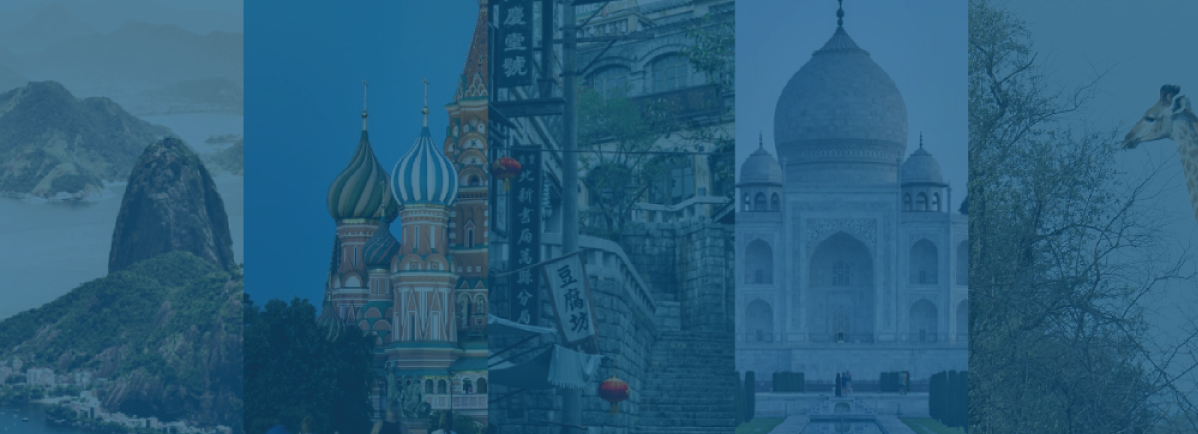5 Countries, 5 Facts: Your Roll-out to a BRICS country
BRICS is the acronym for the combined emerging economies of Brazil, Russia, India, China and South Africa. They come from Asia, Africa, Europe and America, and are all members of the G20. Collectively they account for around 42% of the world’s population and around 26% of the world’s land mass. Analysts have speculated that by the year 2050, these five economies will be the most dominant. In 2011, these five countries were among the fastest growing emerging markets in the world, and in 2015, they generated over 22% of the world’s GDP. These countries definitely do not have a political alliance or even a formal trading association; however, they do have the potential to become a powerful economic power. As the BRICS countries have low production and labour costs, many companies worldwide are recognising them as an opportunity for foreign expansion. Additionally, a study by the European Information Technology Observatory has stated that these up and coming economies are also driving international high-tech markets. Here are some 5 fast facts for you to quickly learn more about BRICS
5 Fast Facts about BRICS:
- An economist came up with the acronym BRICs for Brazil, Russia, India and China in 2001 to describe emerging economies that might challenge the West. The four held their first summit in 2009 and in 2011 South Africa joined to make BRIC into BRICS.
- Two out of five people on this planet come from a BRICS country – that is around about 3 billion people.
- The five nations in BRICS have the bilateral relationship, which focuses on the mutual benefit, equality and non-interference basis.
- Whilst they may be united, BRICS members are all vastly different in culture, literacy, basic human needs, internet usage and opportunities, meaning personal rights and access to education.
- All five BRICS countries are also a part of the G20, which is a group of the world’s top 20 leading industrialised and emerging economies.
SAP Rollout to China: GTS
One BRICS at a time:
Brazil:
Population: 210.8 Million
GDP: 2.138 Trillion USD
United VARs member: Seidor
Did you know? Amongst the BRICS members, Brazil is considered to have the most complicated legal requirements for doing business. Notably the “Nota Fiscal” along with over 60 other different taxes and duties are a part of the legal requirements that cause headaches for companies doing business in Brazil.
Russia:
Population: 143.9 Million
GDP: 1.579 Trillion USD
United VARs member: TeamIdea
Did you know? The Russian language poses as one the biggest challenges in a rollout. As Cyrillic writing is mandatory on all official forms. Therefore, without the support from native Russian speakers, it is almost impossible to meet requirements for developing forms. Read now: What you need to know: ERP integration in Russia
India:
Population: 1.29 Billion
GDP: 2.848 Trillion USD
United VARs member: Answerthink
Did you know? Similar to Brazil, India has an extremely complex Tax system. As of July 2017, a new (GST – Goods and Services Tax) tax system came into play, and the whole system is now automatic. Therefore, business in India is not how it use to be, and locals are the most prepared experts in helping international players.
China:
Population: 1.38 Billion
GDP: 14.092 Trillion USD
United VARs member: Acloudear
Did you know? China’s legal requirements are not as complex as the other BRICS countries; however, particular attention should be given to the Golden Tax solution. The China National Audit Office has also established the ‘nationally valid Golden Audit Report’, and this is mandatory for business within the Shanghai region. Additionally, China is known to have considerable differences across language and culture; therefore, doing business with the guidance of a local will make business projects more successful. Read now: Q&A China: Challenges of the Golden Tax System
South Africa:
Population: 57.7 Million S
GDP: 280.37 Billion USD
United VARs member: Westrocon (Seidor)
Did you know? South Africa has a Broad-Based Black Economic Empowerment (B-BBEE) policy aimed at reducing economic imbalances amongst the historically disadvantaged communities. This is to facilitate a socio-economic transformation, and more specifically, to increase the number of black South Africans owning or managing companies. The B-BBEE requirements demand due consideration by all firms planning to do business with the South African Government, but also within the general business community.

stronger than one
